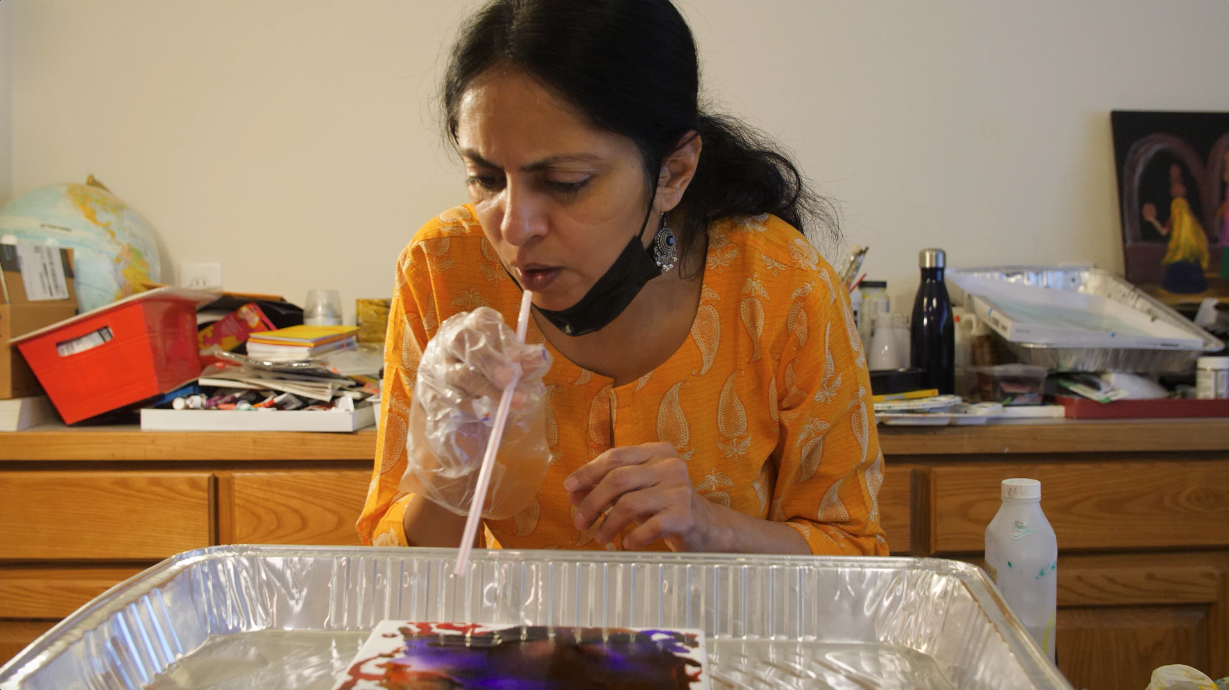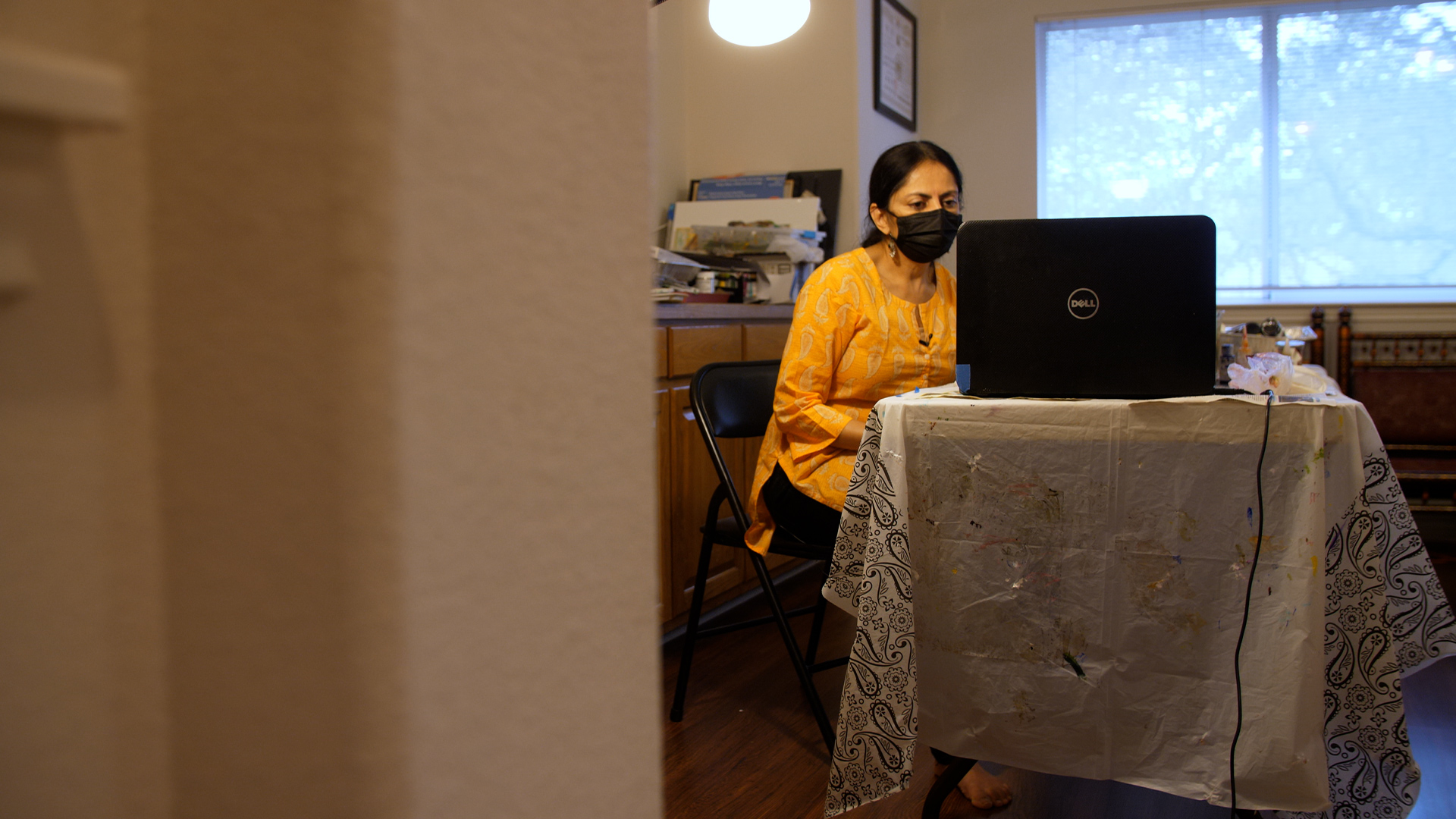Blending Perspectives
From her backyard in Austin, Texas, Shruti Mehta paints a scene from half a world away. Brushstrokes slowly reveal two women in flowing dresses and long, bright veils. To this, Mehta adds stacks of pots on top of their heads.
“These Goomar dancers ... some of them carry up to seven pots,” Mehta says. “And they can balance them, and they dance with those.”
It’s a dance that comes from the Indian state of Rajasthan. Mehta saw it performed a few years ago when she was visiting Jaisalmer with her family. Inspired, she decided to capture the scene on canvas. But it’s not just the dance that’s from the north Indian state, so is the style in which it’s being painted.
“This is Pichhwai,” Mehta says. “It’s only [in] like certain parts of Rajasthan.”
Artist Shruti Mehta works on a painting in the Pichhwai style, an art form from the Rajasthan state of India. Mehta was trained from a young age in many different Indian folk arts.
It’s one of the many folk art styles Mehta has learned. Her studio space is a tour through the country’s rich artistic heritage: Madhubani from the northeast, an artform that used pigments derived from nature to depict the celebratory and the divine; the ancient style of Warli with its geometric patterns sketched upon earthy backdrops; and the Gond style, a celebration of nature in it’s bold, vibrant colors. Each is intricate enough that an artist could spend a lifetime studying just one discipline. Mehta knows them all.
“I love to paint all [the] different styles of Indian art,” Mehta says. “I’m always exploring some new things.”
Mehta began studying painting when she was 12, after a teacher at her school submitted a painting she made for an exhibition. Recognizing her daughter’s nascent talent, Varsha Sheth, Shruti’s mother, approached an art guru to start formally training Mehta. From Avantika Jetley, the art teacher, Mehta learned folk art from across India. She would spend whole weekends at her guru’s house gleaning new skills.
“She was my amazing teacher,” Mehta says. “Any time my guru would praise me, it felt like, okay, I’m reaching some new level here.”
But college would find her reaching other levels and new locations. Mehta came to St. Edward’s University to study for her masters degree in human services. At this point she had begun studying Western styles of art like abstract expressionism and impressionism, but navigating the Western world proved a little more difficult than learning Western art.
Artist Shruti Mehta uses a straw to blow alcohol ink across a fresh canvas. “This is the fun thing about art, experimenting,” she says. Several years ago, Mehta began blending regional Indian art styles with Western disciplines.
“I had to learn a lot after I came here,” Mehta says. “If you go to Hobby Lobby or Jerry’s Art-O-Rama, there's so much material out there, so I had to really educate myself.”
That education would pay off in the form of a bold new style in her work.
“I just had this thought of painting, you know, like how my mom would sit and do my hair,” Mehta says. “Then I was thinking [of] the background ... and it’s like, no, I want to do something different, something unexpected.”
The painting, which depicts a mother and daughter with white flowers in their hair amid a checkered background, braids together Mehta’s experiences. It’s a blend of Indian disciplines and Western abstract expressionism, and it’s a style that’s caught people’s eye.
“I donated that piece for a charity show,” Mehta says. “I didn’t know my husband loved it so much he bought it.”
Mehta and her husband Pratik Mehta have been married for 30 years. He says he bought the painting because it reminded him of his childhood in India, watching his mother chat with his cousins as she oiled and braided their hair.
“I like so many of her pieces, but I felt like this one talked to me,” Pratik says.
While this was the first painting of Mehta’s he bought, it’s certainly not the first creative endeavor of hers that he’s been impressed with.
“I’m not an art expert or anything, so I don’t understand the styles,” Pratik says. “But I’ve seen her do her art and other things for years. … Whatever she touches, she’s able to turn into gold.”
Since that initial foray into blending styles, Mehta has been creating pieces that are a show of her experiences: Gond style paintings with Texas horses, impressionistic depictions of Indian cities and abstract works about Sanskrit words.
“It’s an exciting thing to do, to bring those styles together,” Mehta says. “I’m not taking away from the traditional styles. I still do regular traditional paintings. Mixing them just shows that they can work well together. Not everyone is used to seeing traditional Indian art. When I add these to my abstract expressionism these styles become more known.”
She’s also helping spread the knowledge of Indian folk art by taking on a new venture — teaching. Mehta is currently leading her fourth semester of art classes for the Shiksha school at the Radha Madhav Dham Hindu Temple, teaching both Indian and Western art.
Shruti Mehta starts to trace a design on a canvas along with her students. She enjoys seeing them put their own spin on styles and techniques, creating ‘their own niche’ like Mehta has with her own work.
“I had never visualized myself as a teacher,” Mehta says. “It brought back so many memories from my childhood. Like how would my teacher teach me if I’m not understanding something?”
Her students feel like her teaching method works. Laxmi Gurumoorthy started taking classes this August.
“I’m so engrossed in her class,” Gurumoorthy says. “ [Mehta] doesn’t limit us to what we’re trying to follow. You can let yourself run wild with your creativity.”
Mehta encourages her students, like herself, to explore and discover their own style.
“It’s really amazing that they’re creating their own compositions,” Mehta says. “If I’m teaching a new style, they’ll take that painting, they’ll add their own element to that. It’s like they’re creating their own niche, their own style. So that’s really gratifying.”
Shruti Mehta starts her virtual art class. Now in her fourth semester of teaching art classes for the Shiksha School at the Radha Madhav Dham Hindu Temple, Mehta says being a teacher has changed the way she thinks about her work.
Paints and brushes have been the medium through which Mehta expresses a perspective that is wholly her own. She hopes her students find that same liberation through their work. More than anything, Mehta hopes her students take away a sense of courage to attempt new things, even if mistakes are made along the way.
“This is the fun thing about art, experimenting,” Mehta says. “And sometimes, when you make mistakes you might make something really cool. If you don’t try something, you’ll never create something.”
Community journalism doesn’t happen without community support.
Got story ideas, advice on how we can improve our reporting or just want to know more about what we do? Reach out to us at news@klru.org.
And if you value this type of reporting, then please consider making a donation to Austin PBS. Your gift makes the quality journalism done by the Decibel team possible. Thank you for your contribution.
More in Culture:
See all Culture posts









Contact Us
Email us at news@klru.org